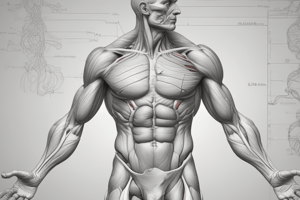Podcast
Questions and Answers
What is the function of the Masseter muscle?
What is the function of the Masseter muscle?
- Depresses the tongue
- Elicits a smile
- Is a major chewing muscle (correct)
- Closes the lips
Which muscle is responsible for elevating and protruding the lower lip?
Which muscle is responsible for elevating and protruding the lower lip?
- Frontalis
- Sternocleidomastoid
- Mentalis (correct)
- Zygomaticus major
What classification does the Stylohyoid muscle belong to?
What classification does the Stylohyoid muscle belong to?
- Suprahyoid muscle (correct)
- Facial muscle
- Skeletal muscle
- Infrahyoid muscle
Which muscle originates on the sternum and clavicle?
Which muscle originates on the sternum and clavicle?
What is the primary action of the Orbicularis oris muscle?
What is the primary action of the Orbicularis oris muscle?
Study Notes
Muscles and Their Functions
- Sternocleidomastoid: Originates from the sternum and clavicle, crucial for head rotation and flexion.
- Sternohyoid: An infrahyoid muscle that plays a role in depressing the hyoid bone during swallowing.
- Orbicularis oris: Muscles encircling the mouth, responsible for closing the lips and facilitating movements such as speaking and eating.
- Zygomaticus major: Known as a smiling muscle, it aids in elevating the corners of the mouth to create smiles.
- Hyoglossus: Muscle that depresses the tongue, important for articulation and swallowing.
- Digastric: Composed of two muscle bellies, it assists in lowering the mandible and is involved in the swallowing process.
- Mentalis: Elevates and protrudes the lower lip, contributing to facial expressions such as doubt or pouting.
- Stylohyoid: A suprahyoid muscle that aids in elevating the hyoid bone during swallowing.
- Masseter: A primary muscle used for chewing, essential for grinding food in the mouth.
- Frontalis: Located in the forehead, it raises the eyebrows and contributes to facial expressions of surprise or curiosity.
Studying That Suits You
Use AI to generate personalized quizzes and flashcards to suit your learning preferences.
Description
Test your knowledge on the various muscles in the human body and their specific functions. This quiz covers muscles such as the sternocleidomastoid, orbicularis oris, and zygomaticus major, highlighting their roles in movement and expression. Dive in to learn more about muscular anatomy!




